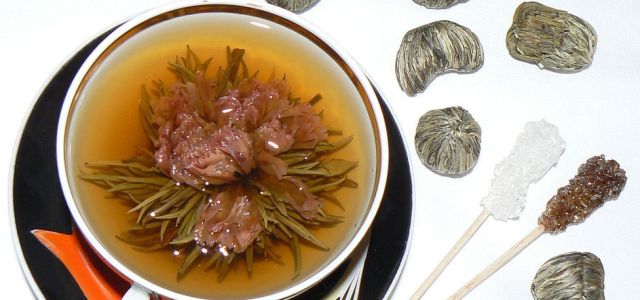
For all of you tea-lovers out there, the tea sipping experience could get much more exciting. If you’ve never heard of flowering tea, keep reading, because this beautiful and entertaining tea steeping process is going to change everything you thought you knew about tea.

Dating centuries back in China, flowering (sometimes called blooming) teas are mostly known for their aesthetic appearance and visuals. What basically happens when you make a pot of flowering tea is an arrangement of leaves and flower buds comes to life in the hot water. The pods that are used for flowering tea expand and spread out when placed in water to create a beautiful scene of herbal leaves and color. I would describe these pods by comparing them to those dehydrated towels that you can buy at a junk store that expand when placed in water.
But flowering tea is much prettier than those dehydrated towels. They’re usually made from buds from tea plants, which are sewn together with edible string. They create a globe-like pocket that has other food-safe flowers and buds sewn inside. Once dehydrated, they look like a little ball. This is what gets dropped into the tea pot of hot water and creates the magical scene before you.

Source: Wikimedia Commons
Although these teas create a visual performance, most would agree that they are not very rich in any particular flavor. Some commonly known flavors are used, like flowers from rose, jasmine, and chrysanthemum plants. But these flavors, which would otherwise be strong, don’t really carry through to the water because they come straight from the buds. These flavors have to be extracted and concentrated to be strong like you might expect them to be. And another factor that dulls out the flavor of blooming tea is the process of sewing the components together. Often times the components have to be moistened so they don’t break while being put together. This moistening process lets out the little bit of flavor or strength that would be there before the tea even gets to your tea pot.
If you can get past this downside, however, and are interested in blooming tea mostly for the show it puts on at your table, then you should be fine. Some of the flowers included in the tea pods include carnations, roses, lilies, marigolds, hibiscus, and more. And with the host of colors and shapes that these flowers provide, the vision inside the water is probably comparable to a garden-like snow globe.
In all, the process of the flowering tea takes several minutes, but it varies from pod to pod. Sometimes the structures are made to pop open into an arrangement, although others are structured to gradually open over the course of time.
If you’re looking for a more engaging tea time experience, you might consider trying your hand at brewing a flowering tea. If anything, it could be a nice party entertainment or special inclusion at a home-hosted event for friends. Get your tea pots ready and prepare for a show!